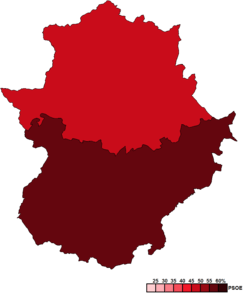1983 Extremaduran regional election
The 1983 Extremaduran regional election was held on Sunday, 8 May 1983, to elect the 1st Assembly of the autonomous community of Extremadura. All 65 seats in the Assembly were up for election. The election was held simultaneously with regional elections in twelve other autonomous communities and local elections all throughout Spain.
| |||||||||||||||||||||||||||||||||||||||||||||||||||||||||||||
All 65 seats in the Assembly of Extremadura 33 seats needed for a majority | |||||||||||||||||||||||||||||||||||||||||||||||||||||||||||||
|---|---|---|---|---|---|---|---|---|---|---|---|---|---|---|---|---|---|---|---|---|---|---|---|---|---|---|---|---|---|---|---|---|---|---|---|---|---|---|---|---|---|---|---|---|---|---|---|---|---|---|---|---|---|---|---|---|---|---|---|---|---|
| Registered | 786,200 | ||||||||||||||||||||||||||||||||||||||||||||||||||||||||||||
| Turnout | 565,244 (71.9%) | ||||||||||||||||||||||||||||||||||||||||||||||||||||||||||||
| |||||||||||||||||||||||||||||||||||||||||||||||||||||||||||||
 Constituency results map for the Assembly of Extremadura | |||||||||||||||||||||||||||||||||||||||||||||||||||||||||||||
| |||||||||||||||||||||||||||||||||||||||||||||||||||||||||||||
The Spanish Socialist Workers' Party (PSOE), under the leadership of pre-autonomic president Juan Carlos Rodríguez Ibarra,[1][2] won a landslide victory by securing 53% of the share and 36 out of 65 seats. The People's Coalition, the electoral alliance of the People's Alliance (AP), the People's Democratic Party (PDP) and the Liberal Union (UL), emerged as the second largest political force with 30% of the vote and 20 seats, whereas United Extremadura (EU) and the Communist Party of Spain (PCE) entered the Assembly with 6 and 4 seats, respectively.[3]
Overview
Electoral system
The Assembly of Extremadura was the devolved, unicameral legislature of the autonomous community of Extremadura, having legislative power in regional matters as defined by the Spanish Constitution and the Extremaduran Statute of Autonomy, as well as the ability to vote confidence in or withdraw it from a President of the Regional Government.[4] Voting for the Assembly was on the basis of universal suffrage, which comprised all nationals over eighteen, registered in Extremadura and in full enjoyment of their political rights.
The 65 members of the Assembly of Extremadura were elected using the D'Hondt method and a closed list proportional representation, with a threshold of 5 percent of valid votes—which included blank ballots—being applied in each constituency. Parties not reaching the threshold were not taken into consideration for seat distribution. Alternatively, parties failing to reach the threshold in one of the constituencies would also be entitled to enter the seat distribution as long as they ran candidates in both districts and reached 5 percent regionally. Seats were allocated to constituencies, corresponding to the provinces of Badajoz and Cáceres. Each constituency was allocated a fixed number of seats: 35 for Badajoz and 30 for Cáceres.[4]
The electoral law provided that parties, federations, coalitions and groupings of electors were allowed to present lists of candidates. However, groupings of electors were required to secure the signature of at least 0.1 percent of the electors registered in the constituency for which they sought election—needing to secure, in any case, the signature of 500 electors—. Electors were barred from signing for more than one list of candidates. Concurrently, parties and federations intending to enter in coalition to take part jointly at an election were required to inform the relevant Electoral Commission within fifteen days of the election being called.[5]
Election date
The Junta of Extremadura, in agreement with the Government of Spain, was required to call an election to the Assembly of Extremadura before 31 May 1983. In the event of an investiture process failing to elect a regional President within a two-month period from the first ballot, the Assembly was to be automatically dissolved and a snap election called, with elected deputies merely serving out what remained of their four-year terms.[4]
Parties and alliances
Parliamentary status
The first election to the Assembly of Extremadura was officially called on 10 March 1983, after the publication of the election Decree in the Official Gazette of the Autonomous Community of Extremadura, with the mandate of the provisional Assembly ending on 8 May.[6] The table below shows the status of the different parliamentary groups in the provisional Assembly at the time of its expiry.[2]
| Parliamentary group | Deputies | |
|---|---|---|
| Socialist Group | 41 | |
| People's Group | 16 | |
| Centrist Group | 5 | |
| Mixed Group | 3[lower-alpha 1] | |
| Total | 65 | |
Results
Overall
 | ||||||
| Parties and coalitions | Popular vote | Seats | ||||
|---|---|---|---|---|---|---|
| Votes | % | ±pp | Total | +/− | ||
| Spanish Socialist Workers' Party (PSOE) | 296,939 | 53.02 | n/a | 35 | n/a | |
| People's Coalition (AP–PDP–UL) | 168,606 | 30.10 | n/a | 20 | n/a | |
| United Extremadura (EU) | 47,504 | 8.48 | n/a | 6 | n/a | |
| Communist Party of Spain (PCE) | 36,294 | 6.48 | n/a | 4 | n/a | |
| Democratic and Social Centre (CDS) | 4,414 | 0.79 | n/a | 0 | n/a | |
| Extremaduran Popular Bloc (BPEx) | 2,249 | 0.40 | n/a | 0 | n/a | |
| Spanish Communist Workers' Party–Unified Communist Party (PCOE–PCEU) | 1,463 | 0.26 | n/a | 0 | n/a | |
| Blank ballots | 2,622 | 0.47 | n/a | |||
| Total | 560,091 | 65 | n/a | |||
| Valid votes | 560,091 | 99.09 | n/a | |||
| Invalid votes | 5,153 | 0.91 | n/a | |||
| Votes cast / turnout | 565,244 | 71.90 | n/a | |||
| Abstentions | 220,956 | 28.10 | n/a | |||
| Registered voters | 786,200 | |||||
| Sources[7][8][9] | ||||||
Aftermath
Government formation
| Investiture Juan Carlos Rodríguez Ibarra (PSOE) | ||
| Ballot → | 7 June 1983 | |
|---|---|---|
| Required majority → | 33 out of 65 | |
38 / 65 | ||
No
|
6 / 65 | |
| Abstentions | 0 / 65 | |
21 / 65 | ||
| Sources[9] | ||
1987 motion of no confidence
| Motion of no confidence Adolfo Díaz-Ambrona (AP) | ||
| Ballot → | 18 March 1987 | |
|---|---|---|
| Required majority → | 33 out of 65 | |
17 / 65 | ||
No
|
36 / 65 | |
Abstentions
|
1 / 65 | |
11 / 65 | ||
| Sources[9][10] | ||
Notes
- 2 EU, 1 PCE.
References
- "Los votos de dos centristas pemiten a un socialista presidir la Junta de Extremadura". El País (in Spanish). 22 December 1982. Retrieved 12 December 2019.
- "Juan Carlos Rodríguez y Pablo Castellano, al frente de los órganos autonómicos extremeños". El País (in Spanish). 6 March 1983. Retrieved 12 December 2019.
- "Rodriguez Ibarra conserva el cargo". El País (in Spanish). 10 May 1983. Retrieved 12 December 2019.
- "Statute of Autonomy of Extremadura of 1983". Organic Law No. 1 of 25 February 1983. Official State Gazette (in Spanish). Retrieved 17 March 2017.
- "Electoral Rules Decree of 1977". Royal Decree-Law No. 20 of 18 March 1977. Official State Gazette (in Spanish). Retrieved 27 December 2016.
- "Decreto 5/83 de la Junta de Extremadura por el que se convocan elecciones a la Asamblea de Extremadura" (PDF). Boletín Oficial de la Comunidad Autónoma de Extremadura (in Spanish) (2): 7046–7047. 10 March 1983. ISSN 9957-196X.
- "Assembly of Extremadura election, 1983". www.datoselecciones.com (in Spanish). Election Data. Retrieved 26 September 2017.
- "Assembly of Extremadura election results, 8 May 1983. Badajoz and Cáceres" (PDF). www.juntaelectoralcentral.es (in Spanish). Central Electoral Commission. 12 September 1983. Retrieved 26 September 2017.
- "Assembly of Extremadura elections since 1983". historiaelectoral.com (in Spanish). Electoral History. Retrieved 26 September 2017.
- "AP se quedó sola en la moción de censura contra la Junta de Extremadura". El País (in Spanish). 20 March 1987. Retrieved 11 December 2019.
.jpg)
